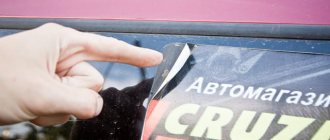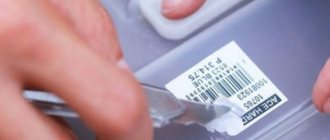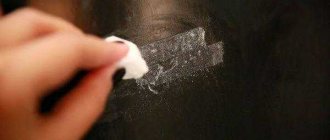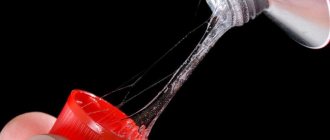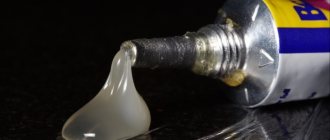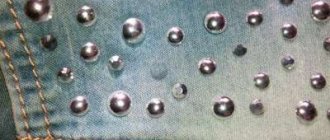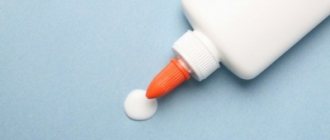Stickers on clothes are a kind of manufacturer identifier and an additional way to attract the attention of a potential buyer to the brand. Not long ago I was choosing baseball caps for my sons for the summer. Huge round iridescent price stickers were on the visors. It doesn’t seem to be a big deal, peel them off and wear them with pleasure. But how do you remove the glue from the sticker? It eats into the fabric, and if you don’t get rid of it, it will collect all the dust and small debris. By the way, I still bought the baseball caps and removed the glue from the label. I’ll tell you in more detail how and with what I did it.
What types of stickers are there?
It is not difficult to remove a sticker from clothing if you know its “origin”. How to distinguish one type of sticker from another? In some cases, a label will help, which will reflect this information, but most often you have to figure it out yourself. So how do you figure out what the design is on your T-shirt or cap?
- Iron-on adhesive. If the relief of the fabric is not visible, and the color scheme of the design is rich in halftones, tints and transitions, you are dealing with a thermal sticker. They are dense and cannot be ironed.
- Thermal printing design. Thermal printing and designs, as well as vinyl images, are not very dense. It will not be difficult to examine the texture of the fabric through such an image.
- Image on fabric.
- Vinyl based applique. Vinyl-based stickers are most often two-color, not too thick. If you look closely, you may notice that the relief of the material is visible through the image.
Ways to deal with sticky marks
Label adhesive can be removed in one of several ways. Let's look at them in order. Firstly, high temperature can come to the rescue. The first thing that comes to mind is to thoroughly warm up the damaged area by blowing hot air on it from a hairdryer.
If the fabric from which you want to remove glue is not too capricious (for example, jeans or a cotton blouse), you can use boiling water. Gently pour water from a kettle over the “disaster” site or soak it in a pan of very hot water. The adhesive substance will quickly steam and come off the material. This method also helps to get rid of chewing gum.
The second cleaning method is to arm yourself with vegetable oil and gently rub the sticky area. The sticky substance will come off, but you will have to deal with the greasy oil residue. In general, it is not necessary to look for unusual folk recipes. Sometimes a regular intensive wash with a high quality powder or liquid detergent is sufficient.
If this cleaning procedure proves ineffective, more creative methods can be used. Try cleaning the stain with kerosene, alcohol or any suitable solvent. First make sure that the potent substance will not harm the tissue itself.
We suggest you read: How to remove cocoa stains from clothes
How to remove iron-on adhesive from clothing
If you are determined to get rid of decorations on your clothes, purchase a special product that will solve the problem in a matter of minutes. For those who do not have this opportunity, there are several options for removing thermal stickers at home using improvised means.
- Dryer. Place the item in the unit and set the temperature to high. When exposed to heat, the adhesive base of the decoration will become more pliable. And you can remove the thermal sticker without much effort.
- Warming up with an iron. Lay out the clothes on a flat surface, place sheets of paper under the image (both the front and back sides). Iron the image with an iron set to the highest heat setting until the decal transfers to the paper.
- Hair dryer or freezer. Not all items can be exposed to high temperatures, and for such cases, use a hairdryer to heat the base of the sticker, or place the item in the freezer for 2–3 hours. In both cases, the surface of the design will begin to crumble and peel off and you will be able to “scrape” it off the surface of the fabric.
The same methods will help remove a drawing or inscription applied with thermal printing from things.
Remove glue marks while they're fresh.
It is very important to clean the sticky area as soon as the label is removed. Otherwise, due to the accumulating dust, a stain will appear, which will require considerable effort to remove. Therefore, when you return home after a successful shopping trip and unpack your purchases, immediately start removing the labels.
You should not postpone this procedure: for example, socks purchased “in reserve” will acquire unsightly sticky marks if you put them in a closet and take them out after a while. On the other hand, freshly applied labels come off without problems and leave almost no adhesive marks.
In addition to the recipes listed above, there is another simple solution that involves using nail polish remover. We recommend using a product that does not contain acetone, otherwise the product may be damaged. Simply apply the liquid to the problem area - this will help get rid of dirt and stuck paper residues.
The choice of cleaning agent and cleaning method depends entirely on the surface that needs cleaning. Hard surfaces are easier to clean than clothes and upholstered furniture. Therefore, the cleaning process has various nuances.
We suggest you familiarize yourself with How to dry apples at home on the balcony and attic?
How to remove a vinyl sticker
You can remove vinyl stickers in the same way as thermal stickers - using heat.
The only difference is that after removing the sticker, you need to wipe the area where the removed pattern was located with vinegar. This will help clean the fabric from any glue residue.
- In addition, you can remove vinyl and other types of stickers using stationery tape. You need to press the adhesive tape firmly onto the image for 2-3 minutes and then quickly remove it. To remove the drawing completely, you will have to repeat the manipulations several times.
Before using tape, make sure that the material from which your item is made does not have an increased tendency to stretch and deform.
Useful tips
Some more useful tips:
Do not apply a new sticker to the fabric immediately after removing the old one. First you need to wash and dry the item completely. In order for the new image to fit perfectly, you should completely get rid of all, even the smallest, traces of the old sticker. This applies to both glue and cleaning agents. Under no circumstances should you use a hot iron without using parchment paper. Be sure to test the effect of aggressive agents on the fabric before removing the sticker. You should always follow the instructions on the clothing label. If you heat the material (polyester) too much, it will simply melt. While working, you should place a soft cloth on the inside of the product. This will help prevent damage to the item.
If this makes the surface too soft, you can use a thin sheet of wood or thick cardboard. If you can’t wash or remove the sticker the first time, you should try other removal methods. It is important to remember that the older the sticker, the more difficult it will be to remove. The stripes are removed using a needle and nail scissors. The threads are cut from the wrong side, and the knots are untangled with a needle.
Cleaning various surfaces
When choosing a cleaning product, think about possible side effects. If you are cleaning furniture, you should not use peanut butter, otherwise the greasy stain will be extremely difficult to remove. On the other hand, if you're wondering how to remove stickers from clothes, peanut butter is a good option.
In this case, the matter can be cleaned without difficulty: just apply the oil to the problem area and gently rub it in. When the cleaning procedure is completed, we wash the item in an automatic washing machine in the standard way: this way, the uncleaned residues will be washed off from the fabric for good.
Sometimes it’s not possible to find the right composition right away. In this case, try several options until the result is satisfactory. In any case, the cleaning algorithm is approximately the same and does not depend on the specific cleaning agent.
Apply the composition to the stained area and gently rub in using a cloth or soft-bristled brush. Gradually, pieces of the sticker will begin to fall off. Then we remove them with a cloth or towel. After complete removal of the glue, you should clean the surface: wash clothes and oversized fabric items, wipe furniture with a damp sponge, and also wash hard surfaces.
In a situation where cleaning was carried out using an oil-based composition, use a stain remover that can dissolve grease for the final treatment. This way you can easily get rid of the oil stain.
Afterwards, the salvaged item of clothing should be thrown into the washing machine or washed by hand. Important clarification: it is better to test the selected cleaning composition to make sure that it will not harm the fabric.
We suggest you read: How to remove black mold from the walls in the house
An effective cleaning method is to use lighter fluid. But this method can be dangerous, so use it only in extreme cases.
Tools used
The adhesive base can be removed manually using detergent.
If this does not help, then use:
- oil: sunflower, corn, olive;
- alcohol;
- vinegar;
- scotch;
- acetone;
- household hair dryer;
- citrus.
Oil
The method is suitable for surfaces that do not absorb fats.
Sequence of procedure:
- The label is soaked in oil and left for 10 minutes.
- Soaked paper is removed with a knife or plastic scraper.
- The product is washed with soap and water, and the remaining glue is removed.
If the house runs out of oil, you can take 20-40 g of mayonnaise.
Alcohol
Use pure homemade alcohol tincture, store-bought vodka, and deodorants.
Procedure:
- A cloth napkin is soaked in the composition.
- Wipe off the adhesive base.
- Rinse thoroughly with hot water.
This method is not suitable for all materials; you should first check it on an inconspicuous fragment.
Vinegar
Suitable for most surfaces, it does not contain “aggressive” chemicals.
Algorithm of actions:
- Apply table vinegar to a cloth.
- Wait 7-10 minutes: the paper will become limp during this time.
- Carefully remove the top layer.
- The glue is wiped with a wet cloth.
If the procedure does not help, repeat several times until the adhesive stain completely disappears.
Scotch
This method will help when the sticker is “fresh” and can be easily removed. Tape is glued to the top and torn off with a sharp movement.
The procedure is carried out several times, rinsing the remaining adhesive base with water.
Baking soda
You need to take a small amount of baking soda and water. Mix the ingredients until a homogeneous paste forms. After this, apply to the contaminated area and rub.
If the stain does not come off, apply a paste of baking soda to the desired area and leave for a few minutes. Then repeat the procedure again.
After removing the stain, the surface must be wiped with a mild soap solution to remove any remaining soda.
Lemon acid
Dissolve a couple of tablespoons of citric acid powder in 100 ml of water. Moisten a soft cloth with the resulting solution and rub the contaminated area.
If the glue does not disappear, then apply the dampened cloth to the stain for a few minutes. After this, rub the stain again and rinse off the acid with clean water.
Lemon
Cut a small lemon into two parts. Rub one of the parts well onto the stain with glue. Lemon juice, when it gets on the glue, breaks it down.
If the glue from the sticker has already dried and ingrained into the plastic, then you can simply leave the lemon on the contaminated area for a few minutes. Then wipe the area with a damp cloth.
If the stain remains, repeat the procedure several times.
Dishwashing liquid
Apply any dishwashing liquid liberally to the area contaminated with glue. After which you need to leave the product for 5-10 minutes, then rub the stain with light circular movements.
Due to the abundant foam, it is necessary to thoroughly wash the contaminated area. Otherwise, soapy streaks will remain.
Vegetable oil
Any vegetable oil can easily remove glue residues on a plastic surface. To do this, it is necessary to evenly apply refined vegetable oil to the adhesive composition. Leave the stain for 10-20 minutes.
After this, armed with a scraper, you need to remove that part of the glue that did not come off on its own. In this case, it is necessary to remove the adhesive layer very carefully so as not to scratch the plastic.
After the entire procedure, thoroughly wash the surface with soapy water.
Construction hair dryer
A hair dryer also copes well with the problem.
You need to use this device to heat the surface with glue, then carefully remove the softened glue from the surface.
It is worth noting that a hair dryer heats up very quickly, so it is important not to overheat the surface. Hot temperatures can cause plastic to become deformed.
After carrying out this procedure, it is necessary to wipe the surface with a weak soap solution.
Stationery eraser
Before using the eraser, the adhesive trace must be moistened with water and left for 15 minutes to soften.
After this, they begin to rub the stain from the sticker with an eraser. It is better to remove the resulting pellets from the surface with a damp sponge.
This method allows you to remove adhesive marks without damaging the surface.
Melamine sponge
We enhance the effect with a melamine eraser sponge. The accessory is used to clean surfaces from stains of various origins. It will help in our case too.
We wet the contaminated area with water and apply the sponge to the stain until it disappears completely.
Mayonnaise
In this product, vegetable oil takes up up to 70 percent. So mayonnaise is quite suitable for removing glue. We proceed in a similar way.
Wet wipes
This method will help with minor contamination. You can rub a stubborn stain until it disappears, but you will have to spend a lot of time and effort.
Laundry soap
Laundry soap is a budget-friendly product that allows you to remove old, cracked patterns from the surface of a T-shirt. You will need:
- heat the water;
- soak the desired item in it;
- soap the print with laundry soap;
- rinse with warm water.
The image is rarely washed off the first time and, in most cases, the procedure will have to be repeated again.
Peanut butter
This product is excellent at destroying adhesives. Therefore, it is even used on clothes. Peanut oil is applied in a thin layer and literally after a minute the glue can be removed. At the end of the procedure, rub the oily stain with laundry soap and leave for 15 minutes, then wash the item. If the grease remains, you will have to repeat the treatment with a professional laundry stain remover.
How to remove a sticker from clothes with an iron
We continue to discover the unusual capabilities of ordinary household appliances. If using an iron, first look at what the applique is made of.
If the design is glued to clothing with a sticky layer, but cannot melt itself, cover the sticker with a damp piece of fabric and then press it with a heated iron. This way the glue heats up very quickly. Remove the fabric from the clothing and quickly, while it is still hot, scrape off the sticker with a knife or similar object.
The downside to this method is that the glue may remain on the fabric. It can be dealt with either with a special tool or in a way that you will read about later.
Also be aware that the glue may leak through the fabric. To prevent this, proceed as you would with a hair dryer.
If there is an image on your clothing that can be melted with an iron, then place a piece of parchment (baking paper) on it, then a damp cloth, and only then heat it with an iron.
Cold
You can get rid of thermal stickers using the freezer. Cold promotes glue transformation. Due to exposure to low temperatures, the glue gradually dries out and begins to bond the pattern with the material worse.
In order to remove the thermal sticker, just set the freezer to the lowest temperature. Then you should put the item in the middle for at least 30 minutes.
After the glue has dried, you should carefully remove the drawing.
Boiling water
For removing stickers, a suitable option is to apply high temperature to the adhesive base of the sticker.
An example of such an application is boiling water. In order for the adhesive base of the former sticker to soften, very hot water is poured onto it. This makes the adhesive layer viscous and pliable. In this state it will be easy to clean.
Using high temperature is only possible with heat-resistant plastic.
Combustible mixtures
Kerosene, refined gasoline or lighter fluid will remove all known types of adhesive papers and films from glass or similar surfaces.
- Wet a cloth or napkin with gasoline.
- Apply a thin layer of adhesive contamination.
- Wait 2 minutes, then wipe with the same cloth until the stain disappears completely.
- Afterwards, you can wash it off with warm soapy water to remove the smell, if any.
The solvent properties of the above mixtures make their use undesirable on a number of surfaces, for example, products painted with alkyd varnishes or paints and some types of plastic.
How to remove stickers from clothes at home
Other types of patterns can be removed from clothing using household chemicals or improvised means. Let's consider the most accessible methods.
This method is best suited for denim and cotton items. Wash clothes by hand or in a washing machine using the highest water temperature. When the product is dry, clean off the remaining design with the blunt side of a knife.
As an alternative to washing, use the ironing method through sheets of paper.
This method is best used for removing stickers from white and light-colored items made from natural and semi-synthetic fabrics. If the item is white, use Whiteness. How to remove a sticker from a T-shirt using detergents?
- saturate the location of the pattern with liquid;
- leave the item for 2–3 hours;
- wash in any way.
If during the washing process you were not able to remove the entire pattern, repeat the procedure again.
Rubbing alcohol will remove stickers from clothing made of any fabric without the risk of damaging the material.
- soak a foam sponge in alcohol and saturate the design;
- leave the item until completely dry;
- Wash the image under running warm water using laundry soap.
After removing the sticker, wash the entire item.
Special means
If traditional methods do not help to cope with the print, you should use special liquids from the category of household chemicals. Their formula is developed taking into account the chemical composition of the glue and the base of fabric stickers.
When choosing a product, you need to pay attention to what fabrics and types of stickers it is intended for. Important criteria are also the complexity of using the liquid, its toxicity and cost.
The most popular brands include:
Goo Gone
The liquid allows you to remove residues:
- glue,
- resins,
- sticky tape,
- grease stains.
The advantage of the product is its composition, which is based on citrus oils. The downside is the greasy residue, which must be removed by washing. According to the cleaning technology, the item is first soaked in a solution of any detergent. Goo Gone is then applied to the print area.
After a few minutes, roll up the sticker with a cotton pad. After this, the item is washed with an increased dose of washing powder. The price of one 50 ml bottle is on average 350 rubles.
Thermoyed
Spray cleaner is designed to remove thermal adhesives. The product wins due to ease of application, but loses due to its high price.
To clean, the solution is sprayed onto the sticker area on both sides of the material. Leave for 1 minute and then clean off the remaining pattern with a napkin. The average cost of a 520 ml bottle is 1800 rubles.
HG sticker remover
A universal product. It is designed to remove stickers, adhesive marks, tape, oil and tar stains. The advantage of this solution is the absence of chlorine. Disadvantages include an unpleasant odor.
To remove traces, liquid is applied to the drawing, left for 3-4 minutes, and then the softened paint is cleaned off with a napkin. If the effect is not achieved the first time, the treatment is repeated.
The price of a 300 ml bottle is on average 300 rubles.
How to remove rhinestones from clothes
- Often the designs on the fabric are decorated with rhinestones and sparkles. How to remove them from fabric? If you need to remove hardware, use a mild knife or metal nail file.
- Using one of these tools, carefully “remove” rhinestones and sparkles from the surface. Do not pull the fabric, act delicately so as not to damage the fibers of the fabric.
- When the decorations are removed, traces of glue will likely remain. You can remove them using one of the methods described below.
Wash
Washing helps if the label is already old and is about to fall off on its own, or if the inscription has almost been erased, but a little remains on the product.
So what should you do?
First, try simply washing the item according to the temperature and cycle.
If this does not help, increase the temperature slightly, but the wash cycle should remain the same
Be sure to pay attention to the material; as the degrees increase, many products shrink or, on the contrary, stretch
If you are afraid of ruining your clothes, it is better not to take risks and use other technologies to flatten the design or remove the label from the fabric.
Precautionary measures
To remove the sticker and completely remove stains from the adhesive base without damaging the material or the skin of your hands, you must observe the following precautions:
- Use rubber gloves when working with chemicals.
- When using special solvents, strictly follow the instructions for use.
- Test the selected products on inconspicuous areas of clothing, even if the product seems safe to you.
By following these tips, you can easily get rid of a sticker that is annoying or has become unusable, and keep your favorite item looking decent.
Solvent
You need to be careful when creating a drawing using a solvent. This composition can not only irritate the skin, but also lead to damage to the fabric structure
As a result, the material will eventually begin to tear without reason and stretch.
It is not recommended to use acetone or thinner on synthetics. The aggressive components of these products dissolve the fibers of things.
They are also used to remove any remaining adhesive after removing a sticker.
How to remove stickers from clothes:
- Wear gloves and protect your respiratory tract. The fumes released may be harmful to the skin and respiratory tract.
- Take the solvent and test it on an inconspicuous area of the T-shirt. If the product reacts well with the product, proceed with removal.
- Apply the solvent to the image using a sponge. Don't pour too much of it, otherwise the T-shirt will be hopelessly ruined. In this technology you need to know when to stop.
- Wait a while. Usually 5–15 minutes is enough. The paint will begin to dissolve and can be easily washed off with water.
The manipulation may have to be repeated more than once. And each time it should be completed with a thorough wash, and not just rinsing in clean water.
Machine or hand wash the item using detergent to remove the solvent from the fabric.
